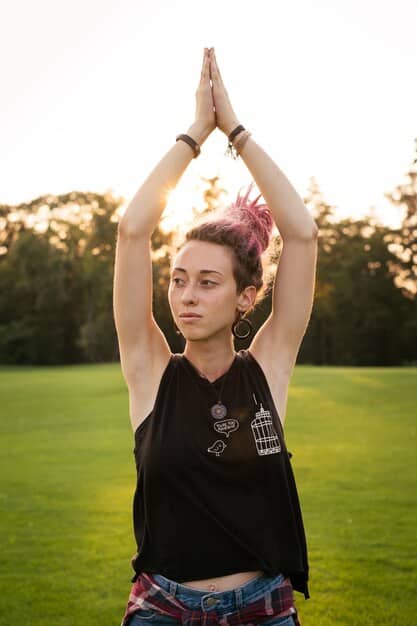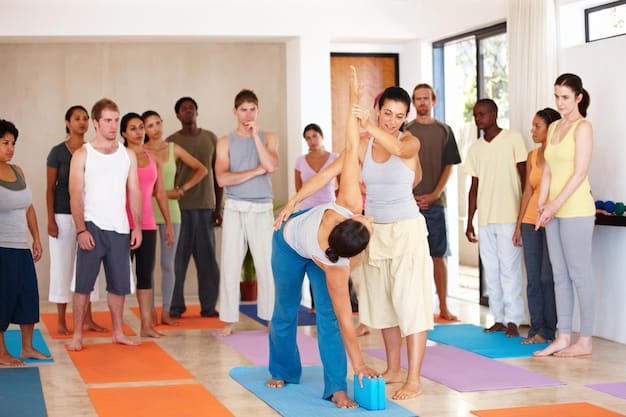Yoga for Athletes: Boost Performance & Prevent Injuries

Yoga for athletes enhances performance and prevents injuries by increasing flexibility, strength, and mindfulness, leading to improved athletic capabilities and reduced risk of physical harm.
Are you an athlete looking for a competitive edge? Or perhaps you’re seeking ways to prevent injuries and prolong your career? Look no further than the practice of **yoga for athletes: enhancing performance and preventing injuries**. It is a holistic approach that combines physical postures, breathing techniques, and mindfulness to create a powerful synergy for improved athletic capabilities and overall well-being.
The benefits of yoga for athletic performance
Incorporating yoga into an athlete’s training regime can unlock a multitude of benefits. It’s not just about stretching; it’s about creating a balanced and resilient physique. Yoga addresses several key areas crucial for athletic success.
Improved flexibility and range of motion
Yoga poses stretch and lengthen muscles like hamstrings, hips and shoulders, increasing flexibility and overall range of motion. This can contribute to reduced muscle tension and tightness.
Enhanced strength and power
While known for flexibility, yoga also builds strength. Holding poses engages multiple muscle groups increasing functional strength, improving power output and boosting athletic performance.

In conclusion yoga enhances athletic performance by improving flexibility, strength, and mindfulness.
Injury prevention through yoga
For athletes, injuries are a constant concern. Yoga can be a powerful tool in preventing injuries by addressing common imbalances and weaknesses. Yoga helps to improve overall body awareness and stability, essential for injury prevention.
- **Increased body awareness**: Yoga cultivates a stronger connection between mind and body, which allows athletes to recognize and respond to subtle cues, like muscle fatigue, reducing the risk of overdoing it.
- **Strengthens stabilizing muscles**: Many yoga poses engage and strengthen the smaller stabilizing muscles around joints, which aren’t always targeted in traditional strength training.
- **Addresses muscle imbalances**: Yoga can help correct muscle imbalances that can lead to injury, strengthening weak areas and stretching tight ones for balanced support.
In short, yoga can prove to be an effective method for injury prevention through increased body awareness and balance.
Yoga styles best suited for athletes
Not all yoga styles are created equal, especially when it comes to the specific needs of athletes. Certain styles offer a more targeted approach to address common issues and complement athletic training. Selecting the right style is key to maximizing the benefits of yoga for your specific athletic goals.
Hatha yoga
Hatha yoga is a foundational practice that focuses on holding poses for longer periods, increasing strength and flexibility. It is ideal for building a solid base and improving body awareness.
Ashtanga yoga
Ashtanga is a more vigorous style, involving a set sequence of poses performed in a flowing, dynamic manner. It is great for building heat, endurance and mental focus.

In brief choosing the right yoga style is vital for athletes.
Integrating yoga into an athlete’s training schedule
Finding the right balance of yoga with your existing training regimen is crucial to reap benefits without interfering with your athletic performance. Strategic timing and gradual integration are key to prevent overtraining and maximize recovery.
- **Recovery days**: Incorporate gentle yoga sessions on recovery days to promote blood flow, reduce muscle soreness, and calm the nervous system.
- **Pre-training warm-up**: A short yoga flow can prepare the body for intense activity, improving flexibility and range of motion without causing fatigue.
- **Avoid before competition**: It is better to avoid intense yoga sessions right before competition. Gentle stretching is allowed.
Yoga can be seamlessly integrated into an athletic training for best results.
Practical yoga poses for athletes
Certain yoga poses are particularly beneficial for athletes, addressing common areas of tightness and weakness. These poses can be incorporated into a regular yoga practice or used as standalone stretches during warm-ups or cool-downs. Proper alignment and mindful breathing are key to maximizing the benefits and preventing injury.
Downward-facing dog (Adho Mukha Svanasana)
This pose stretches the hamstrings, calves, and spine, while also strengthening the arms and shoulders. It enhances blood flow, reduces fatigue, and calms the nervous system.
Warrior poses (Virabhadrasana I, II, III)
Warrior poses strengthen the legs, core, and arms while improving balance and stability. They also open the hips and chest, increasing flexibility and promoting a sense of empowerment.
In closure, yoga offers a multitude of practical poses that benefit athletes for overall well-being.
Mental benefits of yoga for athletes
The benefits of yoga extend beyond the physical realm, offering profound mental and emotional advantages for athletes. These mental benefits can have a significant impact on performance, resilience, and overall well-being. Athletes can learn to regulate their emotions, manage stress, and stay composed under pressure.
- **Mindfulness and focus**: Yoga teaches the ability to stay present in the moment, which translates to improved focus and concentration during training and competition.
- **Stress reduction**: Yoga activates the parasympathetic nervous system, helping to lower cortisol levels and reduce stress. This can improve sleep quality and overall recovery.
- **Improved mental resilience**: Yoga cultivates mental toughness and resilience, allowing athletes to bounce back from setbacks and challenges with greater ease.
Yoga provides mental benefits for athletes, improving focus for better sports performance.
Common mistakes to avoid when practicing yoga
While yoga offers numerous benefits, it’s essential to approach the practice with awareness and caution to avoid potential pitfalls. Being mindful of common mistakes can help you maximize the benefits of yoga while minimizing the risk of injury. Listen to your body, respect your limits, and prioritize proper alignment over achieving the “perfect” pose.
Practicing yoga consciously is essential.
| Key Point | Brief Description |
|---|---|
| 💪 Enhanced Strength | Yoga builds functional strength, improving power output and athletic performance. |
| 🧘 Mindfulness | Improves focus, stress reduction and resilience in athletes. |
| 🤸 Flexibility | Yoga increases range of motion reducing muscle tension and tightness for athletes. |
Frequently Asked Questions
▼
Athletes can practice yoga 2-3 times per week for 30-60 minutes per session. Adjust frequency and duration based on training schedule and individual needs.
▼
Hatha and restorative yoga are effective for injury prevention. They focus on alignment, flexibility, and relaxation, reducing muscle tension and promoting recovery.
▼
Yoga complements but does not replace strength training. It enhances flexibility, balance and body awareness beneficial for athletes.
▼
Child’s pose, Legs-up-the-wall pose, and gentle spinal twists help with recovery. These poses promote relaxation, improve circulation, and reduce muscle soreness.
▼
Yes, yoga can benefit various athletes. Modify poses to meet individual need. Consult professionals if you have specific health concerns.
Conclusion
Embracing yoga can offer athletes a holistic approach to enhancing performance. By incorporating yoga into their training, athletes can unlock new levels of strength, flexibility, injury prevention, and mental resilience, leading to success in their respective sports and a more balanced, fulfilling life.





